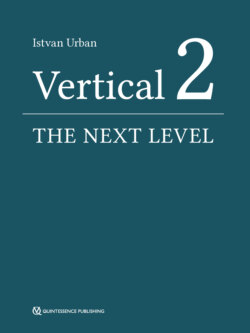Читать книгу Vertical 2: The Next Level of Hard and Soft Tissue Augmentation - Istvan Urban - Страница 37
На сайте Литреса книга снята с продажи.
Representative case examples of ridge augmentation using a perforated d-PTFE membrane
ОглавлениеIn all the following cases, the d-PTFE membrane was covered with a native collagen membrane. This collagen membrane helps to seal the edges of the membrane, where needed, and potentially aids soft tissue healing (Figs 2-5 to 2-66).
The clinical experience is that the bone quality was better than that at the non-perforated sites. Also, it appears that bone formation is faster than before. It is difficult to say how much faster, but the improved quality means that the bone formation was more rapid. A brave estimation is that an average vertical defect may mature faster by a rate of about 2 months. However, this should be carefully investigated in well-designed randomized clinical trials.
In addition to the preclinical studies, the clinical examples shown in Figures 2-5 to 2-66 are encouraging in their demonstration of predictability and stable crestal bone after regeneration in different clinical scenarios.
Fig 2-5 Labial view of a severe posterior maxillary vertical defect.
Fig 2-6 Labial view of a perforated polytetrafluoroethylene (PTFE) membrane in place.
Fig 2-7 Labial view of the fixated membrane.
Figs 2-8 and 2-9 Labial and occlusal views of the regenerated bone with three implants.
Figs 2-10 to 2-15 Vertical augmentation of the posterior mandible.
Figs 2-16 to 2-18 Vertical augmentation of the anterior maxilla.
Figs 2-19 to 2-21 Vertical augmentation of the anterior maxilla (cont).
Figs 2-22 to 2-25 Vertical augmentation of the posterior maxilla.
Figs 2-26 to 2-29 Horizontal augmentation of the posterior mandible.
Figs 2-30 to 2-34 Vertical augmentation of the anterior mandible.
Figs 2-35 to 2-39 Vertical augmentation of the anterior maxilla.
Figs 2-40 to 2-42 Vertical augmentation of the posterior mandible.
Figs 2-43 and 2-44 Vertical augmentation of the posterior mandible (cont).
Figs 2-45 to 2-49 Vertical augmentation of the posterior mandible.
Figs 2-50 to 2-56 Vertical augmentation and sinus augmentation of the posterior maxilla.
Figs 2-57 to 2-60 Vertical augmentation of the posterior mandible.
Figs 2-61 to 2-66 Vertical augmentation and sinus augmentation of the posterior maxilla.
